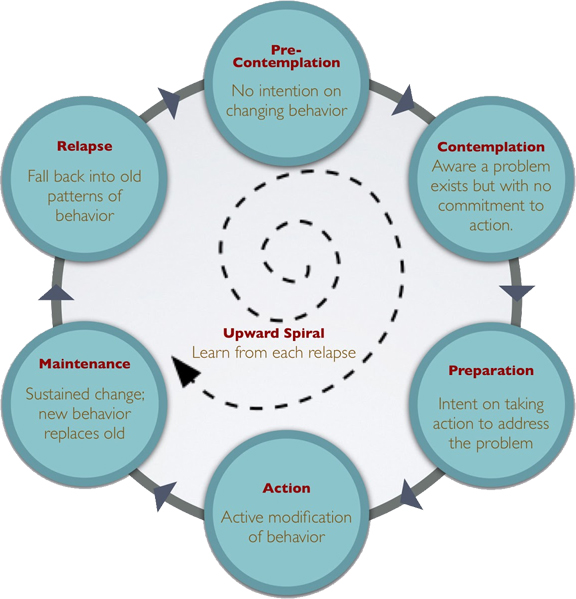Are You Ready To Quit?
When clients come to us, they’re in the Preparation, Action, or Maintenance stage of quitting smoking. When in the Preparation stage, they call to ask us about our service and how we can help with the laser therapy or coaching. In the Action stage they call, ask a few questions, and schedule an appointment. In the Maintenance stage, they may call to set up a stress reduction or booster treatment. If they’ve relapsed, when they call, they’re back in the Preparation or Action stage.

The Transtheoretical Model of Change (TTM) is a widely-used framework for understanding and promoting behavior change. It was first introduced in the 1970s and has since been applied to a wide range of behaviors, including smoking cessation, physical activity, and healthy eating.
The TTM posits that behavior change is a multi-stage process that individuals move through as they progress from pre-contemplation to maintenance.
By the time clients call us, they are generally in the Preparation stage. The stages are:
- Pre-contemplation: Individuals are not yet considering a change in behavior and are not ready to make a change in the near future.
- Contemplation: Individuals are aware of the problem behavior and are considering making a change, but have not yet taken any action.
- Preparation: Individuals have made a commitment to change and are taking steps to do so, such as gathering information or making a plan.
- Action: Individuals have taken concrete steps to change their behavior and have made significant changes in their behavior over the past six months.
- Maintenance: Individuals have successfully sustained the behavior change for six months or more and are working to prevent relapse.
- Termination: Individuals leave the cycle after maintenance never to return to the behavior/addiction again, characterized by a complete commitment to the new behavior and a certainty that they will never go back to their old ways. Some say it’s not clear that this new change will last forever, some of the illustrations in this model consider maintenance the last step while others say termination can be predicted in a person’s lifetime.
Illustration of what this would look like.
In this model, a person can enter and exit at any point. For example, a client may have quit smoking and been smoke free for years, but then one day has a cigarette. This doesn’t mean that all is lost, in fact, the person has made great strides. Imagine going for a 10 mile walk and at the six mile mark, falling and hurting your knee. It takes about 20 minutes to get going again on your way. Do you have to start out on your journey all the way at the beginning? No. You can start where you left off.
In this model, you too can enter again at any point, and people do. Where you enter, is up to you.

The TTM highlights the importance of considering an individual’s stage of change when developing and implementing interventions. For example, individuals in the pre-contemplation stage may need to be provided with more information and education about the benefits of behavior change, while individuals in the action stage may need support and resources to help them maintain their behavior change.
The TTM is an important framework for behavior change because it recognizes that behavior change is not a one-time event, but rather a process that occurs over time. By understanding the stages individuals go through as they change their behavior, healthcare professionals and other practitioners can develop more effective interventions that are tailored to the individual’s specific needs and motivations.